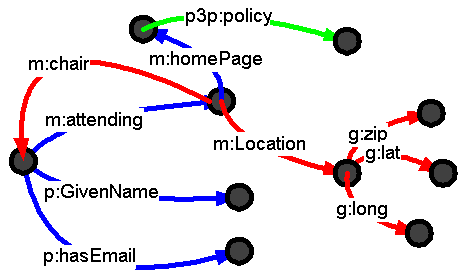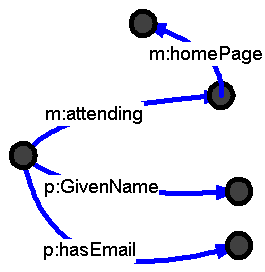























We have increasingly entered the age of networks, in both technological and social systems
More and more of our data is in networks
The loose structure of networks is resistant to analysis
Renyi and Erdos originally based networks upon the theory that the connections between them were random.

Discovered by Watts and Stogratz
A node can be reached from others in small steps
Clustering Coefficient and mean-shortest path length


In Math:
y = cxα
log y = α log(x) + log(c)
The Long Tail and the Giant Component - and it's scale-free

Generated in artificial and evolved systems
Can't do normal Gaussian statistics on networks, including means and average
So visualize!

RDF(Resource Description Framework) is basically just a formal logic for describing a network of links and nodes, where links are called properties that connect subjects and objects:

http://www.ibiblio.org/hhalpin# foaf:knows http://www.w3.org/People/Connolly/#me.
It's semantic because RDF defines a formal semantics that gives the each RDF statements well-defined properties - i.e. it's a data model, not just a syntax.
Is a open world and universal space for machine-readable data.

To a computer, then, the web is a flat, boring world devoid of meaning...This is a pity, as in fact documents on the web describe real objects and imaginary concepts, and give particular relationships between them...Adding semantics to the web involves two things: allowing documents which have information in machine-readable forms, and allowing links to be created with relationship values.TimBL, WWW1994

<#p> foaf:name "PeterS"; <#p> foaf:homepage <http://peter.example.org>.
Note the relationship to HTML links, especially with the re-discovery of the rel attribute.
@prefix rdfs: <http://www.w3.org/2000/01/rdf-schema#>. @prefix foaf: <http://xmlns.com/foaf/0.1/>. @prefix rev: <http://www.purl.org/stuff/rev#>. @prefix vcard: <http://www.w3.org/2006/vcard/ns#>. @prefix xfn: <http://gmpg.org/xfn/11#>. _:hotel vcard:adr [ vcard:locality "Edinburgh" ]; rev:hasReview [ rev:rating 5; rev:reviewer _:who; rdfs:label "Witch's Caldron Hotel, Edinburgh" ]. <jane> xfn:friend _:who. _:who foaf:name "PeterS"; foaf:homepage <http://peter.example.org>.




The Semantic Web is to spreadsheets and databases what the Web of hypertext documents is to word processor files.
| Web | Semantic Web | |
|---|---|---|
| Traditional Design | hypertext | database, spreadsheet, logic |
| + | URIs | |
| - | link consistency | global consistency? |
| = | viral growth | |
XML (Xtensible Markup Language) is a generalization of HTML that lets anyone name the elements and attributes

Think ASCII for the 21st Century!
Also a tree model (DOM - Document Object Model), which is a handy data structure.


RDF statements* are independent. RDF semantics are monotonic.
| RDF | XML | |
|---|---|---|
| Premise |
<Book rdf:ID="book1"> <dc:title>The Grapes of Wrath</title> <dc:creator>Steinbeck</author> </Book> |
<xsd:simpleType name="myInteger">
<xsd:restriction base="xsd:integer">
<xsd:minInclusive value="10000"/>
<xsd:maxInclusive value="99999"/>
</xsd:restriction>
</xsd:simpleType>
|
| Conclusion |
<Book rdf:ID="book1"> <dc:title>The Grapes of Wrath</title> </Book> |
<!-- no, this does not follow -->
<xsd:simpleType name="myInteger">
<xsd:restriction base="xsd:integer">
<xsd:maxInclusive value="99999"/>
</xsd:restriction>
</xsd:simpleType>
|
*RDF/XML does have a rdf:parseType="Collection" syntax, which expands to a lisp style binary tree in the abstract syntax. This erasure property works not on XML elements, but on RDF statements.

Stands for Humanties,Arts,Science, and TechnologyAdvanced Collabotory.

Website: http://www.hastac.org/
Needed an application to make the history of computer science come alive, from point of view of humanities
Tim Lenoir and his research team have been studying platforms
A technology platform is a foundational technology consisting of an ensemble of technology components, subsystems and interfaces that form a common structure from which a stream of derivative products can be efficiently developed and produced. Within a technology platform one or more of the components might be an especially critical "core technology," sometimes a scientific or technological breakthrough that enables the creation of the platform or provides its main competitive leverage. (Lenoir and Giannella)
Kevin Webb has set up http://www.allpatents.org/ allowing searching and querying of U.S. Patent Office Data (in development)
Key points in Compuing History

Problem: Many innovations don't have papers - from commerical labs. Track patents instead

Focuses on Interactions over Visualization
First 3-D RDF Virtual Reality Application
Runs on cluster or one machine
Built using following open-source tools:
Get names of employees from PARC and query using AllPatents...

Retrieved:
Laid out using Kawada-Kawai algorithm (GraphViz) in 2d
Just touch the node

Manipulate the data by pulling it from 2-d to 3-d

From HASTAC Conference
Pull out all nodes connected to a node

It appears that fine-grained answers may be answered better than more coarse-grained questions
Working on a user study!
Mean Time to Solve Tasks in 2-D and 3-D
Sample Questions
North Carolina and RTP are biotech hubs
Mashed-up Gereffi's sociological and economic data on biotech companies (location, number of employees) with their patents
Can we use platform analysis to discover what part of the value-chain that a particular biotech patent holds?
When is a biotech platform emerging?
Is anything missing from the emerging platform? Room for innovation?
Using Fruchterman-Wald, rebuilt code to load and graph large datasets

Working on co-co-citation networks to see how biotech platforms evolve over time
Any Questions?